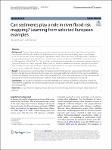Item Infomation
Full metadata record
| DC Field | Value | Language |
|---|---|---|
| dc.contributor.author | Nones, Michael | - |
| dc.contributor.author | Guo, Yiwei | - |
| dc.date.accessioned | 2023-10-02T08:37:07Z | - |
| dc.date.available | 2023-10-02T08:37:07Z | - |
| dc.date.issued | 2023 | - |
| dc.identifier.uri | https://link.springer.com/article/10.1186/s40677-023-00250-9 | - |
| dc.identifier.uri | https://dlib.phenikaa-uni.edu.vn/handle/PNK/9403 | - |
| dc.description | CC-BY | vi |
| dc.description.abstract | Climate change and increasing anthropogenic pressure are two of the major drivers of increasing extreme events like droughts and floods. To deal with the increasing number of flooding events hitting Europe in the last few decades, around twenty years ago the European Commission started to develop ad-hoc legislation to reduce flood risk by mapping flood hazard and risk areas, such as the Directive 2007/60/EC on the Assessment and Management of Flood Risk. This Directive looks to identify regions where flood management strategies should be prioritized. Despite this holistic approach, flaws connected to the consideration of sediment transport and morphological changes in rivers exist, leading to potential underestimations of the impact of floods affecting active watercourses or areas subjected to frequent morphological changes. | vi |
| dc.language.iso | en | vi |
| dc.publisher | Springer | vi |
| dc.subject | river flood risk mapping | vi |
| dc.title | Can sediments play a role in river flood risk mapping? Learning from selected European examples | vi |
| dc.type | Book | vi |
| Appears in Collections | ||
| OER - Khoa học môi trường | ||
Files in This Item:

